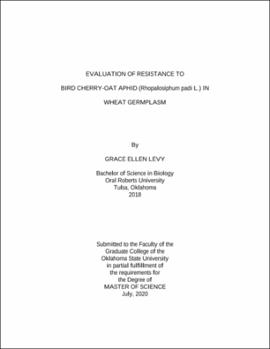| dc.contributor.advisor | Zarrabi, Ali A. | |
| dc.contributor.author | Levy, Grace Ellen | |
| dc.date.accessioned | 2021-02-22T22:41:16Z | |
| dc.date.available | 2021-02-22T22:41:16Z | |
| dc.date.issued | 2020-07 | |
| dc.identifier.uri | https://hdl.handle.net/11244/328656 | |
| dc.description.abstract | Wheat, Triticum aestivum, has been a valuable crop grown around the world and has been cultivated since as early as 7,000 BC (Smith 2005). Because of its worldwide distribution, it is vulnerable to a wide variety of arthropod pests. Notably, bird cherry-oat aphid or BCOA, Rhopalosiphum padi (Hemiptera: Aphididae), is an important pest of wheat in many production areas (Dunn et al. 2011). This aphid is considered to be particularly damaging to wheat crops due to its ability to transmit barley yellow dwarf virus (Jimenez-Martinez et al.2004). An important integrated pest management (IPM) tactic against arthropod pests is host plant resistance, which can be identified in experimental wheat germplasm through proper screening techniques. The purposes of this study were to evaluate the contributing factors in a previously developed screening method and to identify and characterize any existing types of host plant resistance in a set of experimental wheat germplasm entries. The factors contributing most to the overall health score of a plant following intense aphid feeding pressure were determined to be percent chlorosis, the height of the tallest leaf, and the height of the newest leaf. The most valuable contributing factors were used to form a generalized equation for score that may be used to screen for host plant resistance or tolerance against BCOA regardless of the wheat germplasm used. A set of 140 experimental germplasm were also screened to identify to any potential resistant characteristics. Six germplasm entries were chosen for further evaluation to determine the type of host plant resistance present. The 6 germplasm entries showed strong tolerance characteristics with average scores of between 1.8 to 3.1, based on a scale of 1-5 where 1 is the highest score. After antixenosis and antibiosis experiments, none of the 6 entries showed a significant antixenotic or antibiotic characteristics. | |
| dc.format | application/pdf | |
| dc.language | en_US | |
| dc.rights | Copyright is held by the author who has granted the Oklahoma State University Library the non-exclusive right to share this material in its institutional repository. Contact Digital Library Services at lib-dls@okstate.edu or 405-744-9161 for the permission policy on the use, reproduction or distribution of this material. | |
| dc.title | Evaluation of resistance to bird cherry-oat aphids (Rhopalosiphum padi L.) in wheat germplasm | |
| dc.contributor.committeeMember | Royer, Tom A. | |
| dc.contributor.committeeMember | Giles, Kris L. | |
| osu.filename | Levy_okstate_0664M_16845.pdf | |
| osu.accesstype | Open Access | |
| dc.type.genre | Thesis | |
| dc.type.material | Text | |
| dc.subject.keywords | bird cherry-oat aphids | |
| dc.subject.keywords | germplasm | |
| dc.subject.keywords | integrated pest management | |
| dc.subject.keywords | plant resistance | |
| dc.subject.keywords | tolerance | |
| dc.subject.keywords | wheat | |
| thesis.degree.discipline | Entomology and Plant Pathology | |
| thesis.degree.grantor | Oklahoma State University | |
